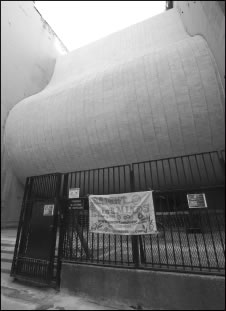By Julie Shapiro
Volume 21, Number 51 | The Newspaper of Lower Manhattan | May 1 – 7, 2009
Synagogue for the Arts was considering using federal Homeland Security money for a new stainless steel fence, but in response to community objections, leaders have decided to just install a new magnetic lock on the gate, replacing the padlock.
Tribeca’s distinct curves won’t get new dressing
The Synagogue for the Arts scaled back plans for a new security fence after Community Board 1’s Landmarks Committee objected to the design.
The synagogue on White St. will keep its black wrought-iron fence largely unchanged, rather than replacing it with a taller, stronger stainless steel version.
“We felt we should get the strongest thing we could find, which is stainless steel,” said Toby Turkel, chairperson of the synagogue’s board of directors. “But their priorities are different from our priorities.”
The Landmarks Committee, whose opinion is advisory, looks mainly at aesthetics and context in making a decision.
The question of context was tricky in this case, because it’s hard to imagine a building more out of keeping with Tribeca’s historic districts — or more beloved by even the neighborhood’s preservationists — than the synagogue.
Designed by William N. Berger and completed in 1967, the undulating facade breaks with the street wall and curves over a raised plaza. If such a striking design were proposed today in the midst of the Tribeca East Historic District, it would likely never get approved, said Bruce Ehrmann, co-chairperson of the Landmarks Committee.
Still, Ehrmann waxed poetic on the building’s design, calling it “exuberantly its own form.” Ehrmann’s primary concern about the proposed stainless steel fence was that it would steal attention from the facade.
The 6-foot-tall wrought-iron fence now in place was more of an afterthought than an integral part of the building’s design, Turkel said. The stainless steel replacement — which would have curved in waves between 7 and 8 feet tall — would have been both an aesthetic and security improvement, she said.
The synagogue started looking to redo the fence when they received a $99,000 grant from the Dept. of Homeland Security for buildings, like synagogues, that are considered potential targets. A previous Homeland Security grant allowed the synagogue to install bulletproof glass, and this time they used some of the money for security cameras, Turkel said.
The synagogue has not faced any specific threats, but Turkel said the fence is important to protect the many people, including children, who use the synagogue’s plaza.
The current fence is not very secure — the gate closes with a padlock that hangs on a rusty chain — and the synagogue saw the grant as an opportunity to also improve the look of the fence.
“A black wrought-iron fence is not very inviting,” Rabbi Jonathan Glass said. The shiny stainless steel poles would have been “a little bit more aesthetic, lighter, pleasant,” he said.
A stainless steel fence would also be easier to maintain, unlike the wrought-iron, which is peeling and rusting in places and needs a fresh coat of paint every few years, said Marvin Traub, a consultant for the synagogue.
Based on the Landmarks Committee’s feedback, the synagogue will use the grant, which expires in June, to just replace the fence’s gate. The new gate will also be wrought-iron, but it will have a magnetic lock with a buzzer, making it more secure, Traub said.
The synagogue’s proposal, which the community board does not oppose, will go before the city Landmarks Preservation Commission soon for final review.
The synagogue could present the stainless steel design to the L.P.C. in case they disagree with the community board. But, Traub said, “We want to get approval and we want to get it done.”
Julie@DowntownExpress.com


































